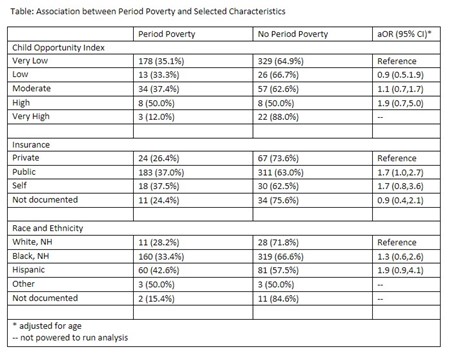An abstract presented during the American Academy of Pediatrics 2024 National Conference & Exhibition measures the prevalence of period poverty in a pediatric emergency department
ORLANDO, Fla.— One in three adolescents who have visited a pediatric emergency department report difficulties in accessing menstruation products, according to research presented during the American Academy of Pediatrics 2024 National Conference & Exhibition at the Orange County Convention Center from Sept. 27-Oct. 1.
Children’s National Hospital Staff Scientist Meleah Boyle, PhD, MPH, co-senior author of the study, said addressing period poverty - as the issue has been called - is a growing area of research in the United States
“Our study highlights the widespread nature of period poverty and the need for broad actions – both locally and nationally – to increase the affordability and accessibility of these products for youth,” Boyle said.
Menstrual equity means that every person who menstruates should have equal access to affordable and quality menstrual products. Unfortunately, many people do not have access to these necessary products. In the study, researchers found that 30% of adolescents do not have the products they need with no differences based on measures of socioeconomic status, such as insurance and community opportunity, or individual differences, such as race and ethnicity.
Prior research estimates that of those who menstruate, 11.9 million struggle to find access to menstrual products. This lack of access can lead to absences from school and/or work as well as adverse health outcomes such as urinary tract infections and bacterial vaginosis.
Boyle said the research highlights the need for public health programs and policy changes to ensure youth have access to the products they need to avoid negative impacts on their health and engagement.
“Ensuring access to healthy and appropriate menstrual health products should be a public health priority,” Boyle said.
Media requests
media@childrensnational.org or kshrader@childrensnational.org
Study co-author and summer student intern, Riya Mehta, is scheduled to present her research from 5:15-6:15 pm ET Saturday, Sept. 28. To request an interview with the authors, contact Katherine Shrader at kshrader@childrensnational.org.
In addition, Monika Goyal, MD, MSCE, the study’s co-senior author and co-director of the Center for Translational Research at Children’s National, will be among the highlighted abstract authors who will give brief presentations and be available for interviews during a press conference from noon12-1:30 pm ET Saturday, Sept. 28 in the National Conference Press Room, W208 AB. During the meeting, you may reach AAP media relations staff at 407-685-5401.
Please note: only the abstract is being presented at the meeting. In some cases, the researcher may have more data available to share with media, or may be preparing a longer article for submission to a journal.
# # #
The American Academy of Pediatrics is an organization of 67,000 primary care pediatricians, pediatric medical subspecialists and pediatric surgical specialists dedicated to the health, safety and well-being of infants, children, adolescents and young adults. For more information, visit www.aap.org. Reporters can access the meeting program and other relevant meeting information through the AAP meeting website at http://www.aapexperience.org/
Abstract
Program Name: 2024 AAP National Conference-Abstracts
Submission Type: Council on Adolescents and Young Adults
Abstract Title: Prevalence of Period Poverty in a Pediatric Emergency Department
Gia Badolato
Washington DC, DC, United States
Period poverty, defined as insufficient access to menstrual hygiene products and menstrual education, impacts 11.9 million females, including 25% of adolescents in the United States. Period poverty may contribute to health issues, such as urinary tract infections and bacterial vaginosis, as well as absences from school/work, which may disrupt education. The objective of this study was to measure the prevalence of period poverty in our pediatric emergency department (ED) and to evaluate the association between period poverty and Child Opportunity Index (COI).
This was a secondary analysis of data collected via the Teen Heath Screen, an adolescent (ages 13-21 years)-completed electronic survey designed to improve sexually transmitted infection detection in the ED. Participants who responded yes to either of the following questions were coded as experiencing period poverty: 1) “If you have had a period during the past 12 months, did you ever have to use something other than a pad or tampon, such as cloths, rags, tissues, or toilet paper or if you have had a period during the past 12 months?” or 2) “Did you need menstrual products but not have the money to buy them?”. Home address was geocoded and linked with COI, a multidimensional neighborhood measure of childhood opportunity based on census tract. The prevalence of period poverty was calculated, and multivariable logistic regression models were used to measure the association of period poverty with COI. Secondary analyses included measuring association of period poverty with insurance status, and race and ethnicity.
There are currently 678 participants meeting inclusion criteria in this ongoing study. Participants had a mean age of 15.9 (+/- 2.1) years and were predominantly non-Hispanic (NH) Black (n=479, 70.6%), publicly insured (494, 72.9%), and living in an area with very low COI (n=507, 74.8%). , More than one-third of all participants (n=236; 34.8%) experienced period poverty during the past 12 months. In separate multivariable models adjusted for age, there were no difference in prevalence of period poverty by COI, insurance status, or race and ethnicity. (Table 1)
One in three study participants reported experiencing period poverty in the past 12 months, with no differences by COI, insurance status, or race and ethnicity. Further research is needed to understand the true breadth of the period poverty among adolescents. To address this inequity, the provision of free menstrual hygiene products should be available in ED bathrooms and during all health care visits. Further, given the widespread prevalence of this need, policy initiatives to make menstrual hygiene products more affordable (e.g. removing tax on menstrual products) and accessible (e.g. providing free menstrual hygiene products in public spaces like schools) should be undertaken.
Association between Period Poverty and Selected Characteristics
